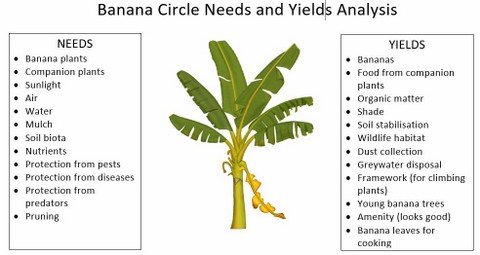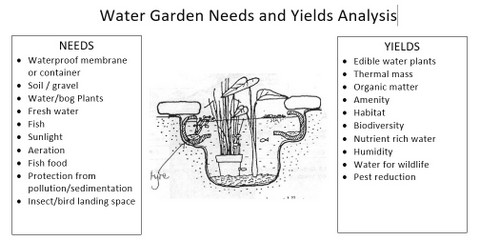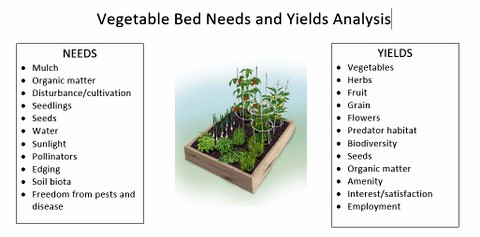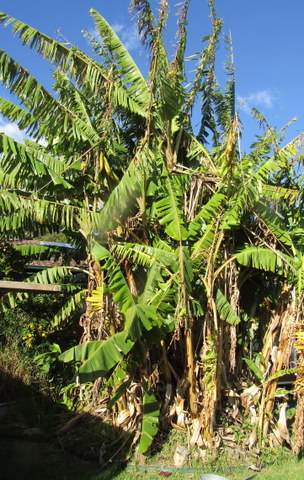
One of the handy things about permaculture is the number of tools developed by practitioners to help you set up systems efficiently to provide for your needs. One of those tools is, as the title of this article suggests, the Needs & Yields Analysis. The funny thing is you don’t see much about it in the permaculture books, just a paragraph here and there. Certainly Danielle and I cover it in the Permaculture Design Course we teach but there is not really much about it even on the net. So I thought I would throw in my experience with what is a very valuable design tool.
However, first it is worth talking about two other concepts in permaculture design with exploring called functions and elements.
A function is what you want your design to deliver when it is in place. Examples might be – Vegetable based foods, Animal based Foods, Social space, Craft, Cooking, Heating & lighting, Water supply, Hygiene, Employment and/or Habitat/biodiversity.
An element is what you put in place to achieve the functions you plan for in your design. So in terms of achieving the vegetable based food production function referred to above, the elements to be put in place might be veggie beds, a vertical garden, banana circle or productive water garden.
A good design philosophy (or permaculture principle) to ensure there is some resiliency in your design is to ensure that each element performs more than one function and each function is supported by more than one element. For example, the water tank put in to store rainwater (its primary reason for being) will also –
- provide a vertical growing space for climb fruit and veg,
- provide thermal mass that modifies a microclimate to allow productive plants to be grown out of season, and
- provide shade for an external wall, reducing solar heat gain of a structure in summer.
With resiliency in the system if one element fails to deliver its function, others can take over so that you are not totally at a loss for that particular function.
To make the most of this effect we need to understand the connections between the various elements within and between each function, and to understand the connections between the various elements we can use the Needs and Yields Analysis.
Conducting a Needs and yields Analysis
To conduct this properly it would be good to have a comprehensive listing of functions and elements for your design. It might not even be a formal design, it could just be a list in your head of things you want from your house, yard etc and what you are going to do to achieve them.
If you have a fair idea of the elements you are looking at putting in, write them down as a list and then conduct an analysis on each one.
For each element, make a list of the things it needs to be productive, to satisfy the function for which it was installed. To get the best result out the analysis, you need to be creative and not just go for the obvious. For example if we are talking about a productive water garden, it would need a liner or container of some description, soil, water, plants and fish to keep down the mosquitoes – but it could also need aeration (natural or created), protection from pollution or sedimentation and a place where insects and birds can access the water without risk of drowning.

So now you have a list of needs which your element (in this case water garden) requires to be satisfied if it is to be productive. It will also have yields or things it gives back to you which you need to identify and write down, again, being as creative as you can. For our hypothetical water garden you want to get back something edible from your water plants and also you want it to be nice to look at. Other less obvious yields are microclimate effects from the thermal mass of the water, nutrient rich water which can be used to fertilise plants and improved biodiversity in your yard due to the availability of water which will attract new species.
Over time, sit down and look closely at all the proposed elements for you design and go through the needs and yields process with each one. In and of itself, a needs and yields analysis is valuable in demonstrating what you need to provide for each element before it is put into place and gives you a good idea what you can expect to gain from each element after it is in and working. However, the real value of the process is in using your completed needs and yields analyses to uncover and map connections between the elements.
A way of putting your analyses into a format which will make analysis easier is to type or write out your two lists (one for needs, one for yields) with a couple of words in each entry. Put the needs list on the right hand side of an A4 sheet of paper, yields on the left hand side and then a picture of the element being analysed in the middle. You can fit 2 or 3 complete analyses on each sheet of paper. Then cut them out so the analyses are on separate “cards”.

To look at connections, get hold of a larger piece of paper, butchers paper would work well, then arrange the analysis cards randomly on it. Look for connections where a need of one element is a yield from another and vice versa. For example a rainwater tank needs the yield of rainwater from a garden shed roof and then provides the rainwater to a water garden. A deciduous fruit tree needs organic matter and mulch which can be provided from a composter, the composter can be fed leaves from the fruit tree as part of the organic matter it requires.
The whole point of this secondary analysis is to –
- Indicate how elements are connected so that they can be grouped together to make interactions easier.
- Show how rather than buy in the needs of an element they may be served by the yields of another element or elements.
- Point out needs which cannot satisfied by the design as it stands, and
- Demonstrates the possibility for undiscovered yields which could be used to satisfy the needs of elements not yet included in the design.
The Wrong Way
A few years ago some friends put a banana circle in for us, I hadn’t put much thought into where it should go so when they turned to put it in I looked around the front yard and picked an area which was free, after virtually no analysis. It turned out to be the wrong place!
From a needs & yields analysis the bananas need –
- Banana plants
- Companion plants
- Sunlight
- Air
- Water
- Mulch
- Soil biota
- Nutrients
- Protection from pests
- Protection from diseases
- Protection from predators
- Pruning
Some of the most important of those needs are sunlight, water and nutrients. Where I had located the banana circle it was shaded by other trees, the soil was quite poor and there was no easy access to water. We piled organic matter into the centre of the circle but it became so dry that it took forever to break down. It had always been my intention to run the greywater (which exits from the other side of the house) via a pump out to the banana circle but it never happened. The banana circle was also hidden by the other trees so didn’t get looked at as often as it should have. All of this meant that in over 5 years of growing banana trees there were no bananas!
After careful analysis I decided to move the banana circle to an open space in the backyard (I had to remove and old scabby lemonade tree first). With everything cleared a shallow depression was dug and the soil mounded up, more well drained soil was also heaped up to make a higher mound after being mixed with added nutrients (chook poo from the chooks and wood ash from the fire). The greywater output from our spa bath was run into the central depression to provide water automatically every time we took a shower. The bananas were planted and mulched as well as having some companion plants added (nasturtiums and sweet potato) to act as ground cover around the bananas.
The effect has been that the banana trees that are thicker, leafier and healthier after 5 months in their new position than they were in 5 years in the other location. The organic material in the centre stays moist and is breaking down quickly and the hot dry weather we have had lately has had no adverse effects on the bananas now that their roots are into the cool, moist central depression. A harvest of bananas themselves are only a matter of time, but we also can look out the kitchen window and see them waving in the breeze looking lovely and tropical. I’m happy now but if I had done the analysis 5 years earlier……..
Other data including example Needs and Yields analyses can be found here





